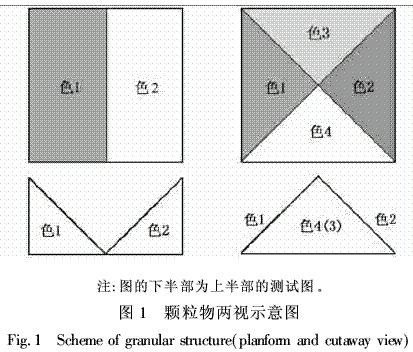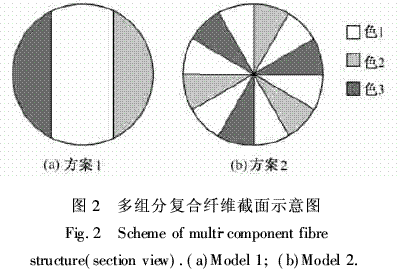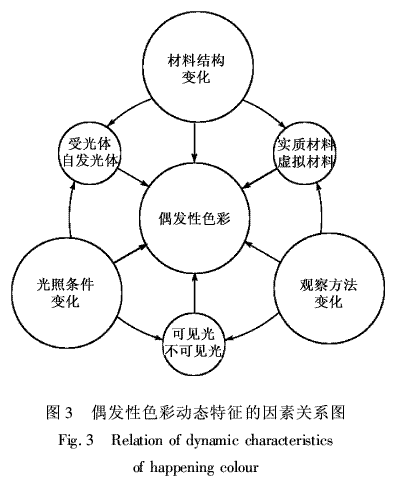Influential factors of sporadic color dynamics and its generation process Pan Chunyu1, Gao Weidong1, Wu Wenzheng 2
(1. Key Laboratory of Eco-Textile Ministry of Education (Jiangnan University), Wuxi 214122, Jiangsu; 2. Department of Textiles and Clothing, Hong Kong Polytechnic University, Hong Kong)
Abstract: According to the definition of sporadic color, the dynamic feature is the main sign that sporadic color is different from other color types, especially traditional static color. It is concluded that sporadic color dynamic characteristics can be expressed as transcendence, non-condensation, non-standard. Sex and adaptability. The dynamic feature generation process of sporadic color is analyzed emphatically. It is pointed out that the change of illumination condition, material structure change and observation mode change and its interaction are the main influencing factors of sporadic color dynamic feature generation, and further improve the theoretical study of sporadic color. It has expanded the ideas for modern textile design, enriched the technical means, and helped to improve the technical content of textile design.
Key words: sporadic color; dynamic feature; textile design; material structure CLC number: TS 1 Document code: A
Article ID: 0253-9721 (2009) 12-0086-04
Some of the colors of nature, such as the indefinite effect of the insect carapace's "single color by flashing light" [1], have become one of the important topics in contemporary color science research. Research on the new all-terrain camouflage suits in the United States under natural light shows that this sporadic color that exhibits motion in time and space has important guiding significance for modern textile design. The so-called sporadic color refers to the open color phenomenon formed by the accidental factors in the textile design, which is unevenly distributed, without figurative or abstract geometric contours. It especially emphasizes the uncertain accidental factors in the generation process. The effect of the state [2]. This paper introduces the difference between sporadic color and traditional static color, analyzes the specific performance of its dynamic characteristics, discusses the main factors affecting dynamic features in the process of sporadic color generation and the relationship between the elements, which can be related to the change of color appearance. Theoretical support for contemporary textile design with color sensing control and color dynamics.
1. Dynamic characteristics of sporadic colors Generally, the appearance of a designed product is stable and uniform in color appearance—static color, and textiles are no exception. However, in recent years, this static color impression has been changed by sporadic color concepts. In some textile designs, color has become a process of variable and multi-dimensional appreciation and vitality. The heavy process is one of the distinctive features of modern art. It is in this aesthetic experience of the creative process that the artist realizes the inner emotional essence of “ecstasy†[3]. The sporadic colors that focus on the generation process are more dynamic than the stable, uniform static colors, which is more conducive to stimulating the viewer's imagination.
1.1 Dynamic and static differences of sporadic colors The dynamic characteristics of sporadic colors are not only the expression of contemporary textile color design, but also the subject of its performance. In practical applications, it can be divided into two parts: dynamic process and dynamic effect.
In the dynamic process of sporadic color, the elements of "time" are directly introduced. "Time is a scientific and philosophical category that reflects the order and persistence of things and life movements, changes, and development processes." [4] Something accidental At some point in time, the factors involved in the process of textile color generation, changing the general orientation of uniformity and stability in color generation, resulting in significant random and variable shape and movement of color [5].
The dynamic process of sporadic colors may also solidify in a static form, which can be called dynamic effects, such as traditional tie-dye effects. However, since the sporadic color has no specific morphological symbol in the final dynamic effect, and there is no clear theme guidance, the viewer will focus on the process of forming the dynamic effect, so the dynamic effect and dynamic process of the sporadic color are Unified, dynamic effects are the carrier of dynamic processes.
1.2 Analysis of sporadic color dynamic characteristics Sporadic color is inseparable from the guidance of dynamic concepts and dynamic thinking. Its dynamic characteristics show transcendence, non-condensation, non-standard and strain in textile design.
Transcendence refers to the fact that sporadic colors are endowed with static colors by motion. On the one hand, the dynamics make the surface of the original stable single material get the rhythm of rhythm. On the other hand, "because these materials are in motion, the original shape, color, and material produce visual illusion, which causes the originality to be blurred and merged. Change." [4] The modern art theorist Gombrich believes that human perception prefers simple structures such as straight lines, circles, and its simple order. What is easy to see in the chaotic outer world is this type of regular shape, not its messy shape [6]. The non-condensation of sporadic colors means that it is often in a state of constant instability and cannot be condensed into a regular shape. Edge chaos often prevents viewers' perceptions from accurately distinguishing their complex color structures and relationships.
The traditional mode of color management is based on static color, based on color stereo, and color card as evaluation standard [7]. Although it is convenient to control color in textile mass production, it excludes more vivid occasions. Sexual color and dismiss it as a "defective".
Non-standard means that sporadic colors are independent of traditional standard color stereo systems because they cannot be decomposed into one-sided numerical features such as hue, purity, and brightness. The analysis and control of color standardization has to give way to the discovery of sporadic dynamic beauty, which is precisely the premise that emphasizes the differentiation of differentiated production and modern consumption aesthetics in the post-industrial era.
On the one hand, the strain of sporadic color refers to the form, timing and degree of intervention of the textile color in the process of production, which causes the color effect to change; on the other hand, the viewer participates in the color generation process as one of the accidental factors. Therefore, textiles will produce obvious sports color effects in use in the form of "human-color" interaction. It can be seen that dynamic sporadic color is one of the fundamental attributes of modern textile design that is different from traditional color concept.
2. Influencing factors of sporadic color generation process 2.1 Influence of changes in lighting conditions Generally speaking, textile colors are displayed under continuous and stable lighting conditions, and human color perception is constant, people tend to subjectively ignore color light. The color difference caused by small changes recognizes the stable intrinsic color as the true face of textile color.
If you consciously change the lighting conditions and control the intensity and rhythm of the color, then the continuous change of light will change the static color to sporadic color and enhance its dynamic characteristics. This kind of light that can be accurately controlled and rapidly changed by computer is derived from stroboscopic lamps, lasers or other scanning light. The intermittent changes in the state of action such as hue, intensity and frequency will turn the originally stable light into time. And more spatially complex color information, the textiles that viewers see have unpredictable dynamic colors.
2.2 Influence of material structure change Under the premise of constant illumination conditions, textile surface texture is the most important objective condition for the formation of sporadic color dynamics.
2.2.1 Surface modification of traditional textiles The color-changing materials capable of selectively absorbing invisible light are made into microcapsules and dispersed in the resin, coated on the surface of the fabric by coating method, or dispersed in an adhesive. The method of coating printing forms a flower color [8]. Extremely subtle dot-like colors produce corresponding color changes with external stimuli that cannot be precisely controlled.
Other materials do not discolor themselves, but can reflect different shades of light at different angles. For the overall color appearance of textiles, the dynamics are sporadic; and some fabric surfaces are coated with particles of different colors in different dimensions, such as As shown in Fig. 1, from different angles, it can be seen that different color points have an advantage in quantity, thereby forming a certain color tone. If there are two or more colors in a certain angle, the color points of these different hues will form a color mixture in the viewer's eyes, which becomes a more complicated surface discoloration. 
In the cross-section design of modern multi-component composite fibers, the fiber-forming raw materials of different compositions are combined by conjugate spinning to form a whole-side shaped fiber, and the fiber is formed on the surface after dyeing because of different dyeing properties. The color difference, the cross-sectional schematic diagram shown in Figure 2, after the textile is made, it will also determine the dynamic color tone seen by the spatial mixing of the small color points. The composite fiber with satellite-type distribution also has the appearance effect of mottled transformation due to the color combination of the sheath wire [9]. 
2.2.2 Surface innovation of new materials The development of materials science provides strong technical support for the formation of sporadic colors. The liquid crystal with optical anisotropy can be made into a flexible liquid crystal screen, and has the performance of taking textiles. When equipped with a camera, a photoelectric converter, and a processing controller to make smart clothing, the color of the changing environment can be instantly reflected. The surface of the garment achieves a special color effect of dynamic stealth. If combined with inductive technology, these innovative materials will make random changes to the invisible factors such as temperature, humidity, magnetism, and sound in the environment, and even some functions of the observer's human body such as eye movement, heartbeat, respiration, pulse, and mood swings. The response is to use dynamic color as a form of expression to achieve more interesting sporadic effects.
2.3 Effects of changes in observation methods Human factors are essential in the formation of sporadic colors. Whether it is the dynamic process or the dynamic effect of sporadic color, it will sensitively reflect the subjective change and objective movement of people.
2.3.1 Subjective changes in observation methods The sporadic color opposes the objective color of the surface of the simulated material, and advocates the expression of abstract emotions in the mental state of “undressing the shacklesâ€, so the viewers also need to indulge their emotional fluctuations to be able to The creators of sexual color resonate. The emotional changes in the observation method are subtle and difficult to quantify, but they have a tangible effect on the observation of dynamic colors. When the observer's mood is high, he will be more active to follow the dynamic changes of color, more sensitive to distinguish subtle color changes, and more interested in the experience of color illusion.
2.3.2 Observing the relative displacement of the subject and the object The dynamic characteristics of the sporadic color liberate the spatial position of the viewer and the work in time and space, especially in motion. Unlike static oil paintings, the flutter, rotation or vibration that it presents in use actually provides the viewer with a sporty perspective to capture the random colors of the moment. For example, the linear color of the surface of the textile is set to a slight difference in the arrangement angle. When it moves relative to the position of the viewer, regular color line conversion or irregular color line misalignment may cause displacement, coincidence, and interlacing. Change to produce a wonderful sporadic color effect.
2.4 The combined effects of the three factors In the formation of sporadic colors, if the three main influencing factors of illumination conditions, material structure and observation mode are consciously combined, it will contribute to the full expression of sporadic color dynamic features, such as Figure 3 shows. 
The wavelength of light is different, and the human eye can only directly see a part of the color light (380~760 nm). Then, using a paint printing which only has a color rendering effect on some light, or superimposed on the ordinary pigment, the color effect observed under normal light conditions is completely different from the color effect obtained by the special light excitation color development, and the fluorescence is completely different. The color of the paint before and after the excitation of light also has the same difference [10]. When light of different nature alternates, the color of the fabric will produce a dynamic effect. If the light source switching and the synchronization of the motion rhythm are technically controlled, the speed change of the color response will more highlight the sporadic effect.
Unlike most non-illuminated textiles, new materials such as rare earth fibers and long afterglow light storage coatings can be used to form new textiles with their own luminous capabilities. A more straightforward approach is to weave a series circuit of light-emitting components, such as light-emitting diodes, into the textile to form a colored point of illumination. Using a microcomputer program to control the speed and distribution of its flashes can create unpredictable dynamic colors.
It can be seen that the relationship between light and materials is inseparable, and the transformation and innovation of materials provide a better display medium for sporadic colors. In the dynamic performance of sporadic colors, more performance vectors can be tried, blurring the boundaries between real materials and virtual materials, and creating virtual colors on various uneven amorphous materials such as air, smoke, and water. The combination of sporadic colors and virtual materials helps to overcome the mechanical limitations of the physical material, transforming the color from the appearance of the physical material into the illusion of time and space movement of light, highlighting its immateriality.
3. Conclusion The uncertainty brought about by sports and development gives people the passion to explore sporadic colors. The sporadic color is guided by the dynamic concept that is different from the traditional static color, which provides a new idea for textile design.
The transcendentality, non-condensation, non-standardity and strainability of sporadic colors all show dynamic uncertainties that vary with conditions, so dynamic features are a concentrated expression of the typical characteristics of sporadic colors. The current state of sporadic color is a piece of the entire space-time process, and it is also the continuation of the previous piece and the paving of future pieces. In the process of artificially intervening the generation of sporadic color dynamic features, it is necessary to find the possibility of technological breakthrough from the three directions of illumination conditions, material structure and observation method. In particular, it is necessary to combine the three to fully play the sporadic The advantages of sexual color dynamics in contemporary textile design.
References: slightly
Ultra Plantâ„¢ Grow Light offers One Chip Technology aimed to meet your indoor growing expectation such as improve plants' quality, increase yield, or better the margin, etc., all for helping you realize a higher return on your crops.
Ultra Plantâ„¢ Grow Light is combined our advanced All-In-One technology with patented optical design and customized light full spectrum supported from our experienced LED engineers, plant specialists and other partners working on horticulture.
From Ultra Plantâ„¢ APP, you are able to schedule the growing process including photoperiod, brightness and spectral in advance. The lighting system will help you grow smarter, easier and better.
Ultra Plantâ„¢ is the most versatile horticultural grow lighting fixture for indoor plants with flexible full spectrum, brightness control and uniform, wider light distribution, suitable for top lighting of all types of crops. No matter it applies to anywhere for any crop, Ultra Plantâ„¢ can do perfect work for you.
Grow Light On Flowering,Flowering Grow Lights,Red Light For Flowering,Led Grow Light For Veg And Flower
Feton Corporation , https://www.ultraplantgrowled.com